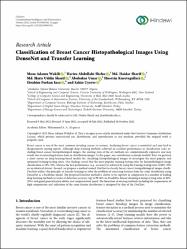| dc.contributor.author | Wakili, Musa Adamu | |
| dc.contributor.author | Shehu, Harisu Abdullahi | |
| dc.contributor.author | Sharif, Md. Haidar | |
| dc.contributor.author | Sharif, Md. Haris Uddin | |
| dc.contributor.author | Umar, Abubakar | |
| dc.contributor.author | Kusetoğulları, Hüseyin | |
| dc.contributor.author | İnce, İbrahim Furkan | |
| dc.contributor.author | Uyaver, Şahin | |
| dc.date.accessioned | 2023-02-23T08:43:24Z | |
| dc.date.available | 2023-02-23T08:43:24Z | |
| dc.date.issued | 2022 | en_US |
| dc.identifier.citation | Wakili, M. A., Shehu, H. A., Sharif, M., Sharif, M., Uddin, H., Umar, A., ... & Uyaver, Ş. (2022). Classification of Breast Cancer Histopathological Images Using DenseNet and Transfer Learning. Computational Intelligence and Neuroscience, 2022. | en_US |
| dc.identifier.uri | https://hdl.handle.net/20.500.12846/702 | |
| dc.description.abstract | Breast cancer is one of the most common invading cancers in women. Analyzing breast cancer is nontrivial and may lead to disagreements among experts. Although deep learning methods achieved an excellent performance in classification tasks including breast cancer histopathological images, the existing state-of-the-art methods are computationally expensive and may overfit due to extracting features from in-distribution images. In this paper, our contribution is mainly twofold. First, we perform a short survey on deep-learning-based models for classifying histopathological images to investigate the most popular and optimized training-testing ratios. Our findings reveal that the most popular training-testing ratio for histopathological image classification is 70%: 30%, whereas the best performance (e.g., accuracy) is achieved by using the training-testing ratio of 80%: 20% on an identical dataset. Second, we propose a method named DenTnet to classify breast cancer histopathological images chiefly. DenTnet utilizes the principle of transfer learning to solve the problem of extracting features from the same distribution using DenseNet as a backbone model. The proposed DenTnet method is shown to be superior in comparison to a number of leading deep learning methods in terms of detection accuracy (up to 99.28% on BreaKHis dataset deeming training-testing ratio of 80%: 20%) with good generalization ability and computational speed. The limitation of existing methods including the requirement of high computation and utilization of the same feature distribution is mitigated by dint of the DenTnet. | en_US |
| dc.language.iso | eng | en_US |
| dc.publisher | Hindawi Publishing Corporation | en_US |
| dc.relation.isversionof | 10.1155/2022/8904768 | en_US |
| dc.rights | info:eu-repo/semantics/openAccess | en_US |
| dc.subject | Rejective Multiple Test | en_US |
| dc.subject | Neural-Network | en_US |
| dc.subject | Gradient Descent | en_US |
| dc.subject | Mammograms | en_US |
| dc.subject | Approximations | en_US |
| dc.subject | Reddedici Çoklu Test | en_US |
| dc.subject | Sinir Ağı | en_US |
| dc.subject | Gradyan İniş | en_US |
| dc.subject | Mamogramlar | en_US |
| dc.subject | Ablehnender Mehrfachtest | en_US |
| dc.subject | Neuronale Netze | en_US |
| dc.subject | Gradientenabstieg | en_US |
| dc.subject | Mammogramme | en_US |
| dc.title | Classification of breast cancer histopathological images using DenseNet and transfer learning | en_US |
| dc.type | article | en_US |
| dc.relation.journal | Computational Intelligence and Neuroscience | en_US |
| dc.contributor.authorID | 0000-0001-8776-3032 | en_US |
| dc.relation.publicationcategory | Makale - Uluslararası Hakemli Dergi - Kurum Öğretim Elemanı | en_US |
| dc.contributor.department | TAÜ, Fen Fakültesi, Enerji Bilimi ve Teknolojileri Bölümü | en_US |
| dc.contributor.institutionauthor | Uyaver, Şahin | |
| dc.identifier.wosquality | N/A | en_US |
| dc.identifier.scopusquality | N/A | en_US |

















